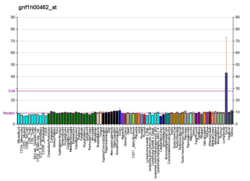FCRL4
Fc receptor-like protein 4 is a protein that in humans is encoded by the FCRL4 gene. FCRL4 is an inhibitory receptor expressed on human memory B cells which resides in epithelial tissues.[3][4][5]
| FCRL4 | |||||||||||||||||||||||||
|---|---|---|---|---|---|---|---|---|---|---|---|---|---|---|---|---|---|---|---|---|---|---|---|---|---|
| Identifiers | |||||||||||||||||||||||||
| Aliases | FCRL4, CD307d, FCRH4, IGFP2, IRTA1, Fc receptor like 4 | ||||||||||||||||||||||||
| External IDs | OMIM: 605876 HomoloGene: 88926 GeneCards: FCRL4 | ||||||||||||||||||||||||
| |||||||||||||||||||||||||
| |||||||||||||||||||||||||
| |||||||||||||||||||||||||
| Orthologs | |||||||||||||||||||||||||
| Species | Human | Mouse | |||||||||||||||||||||||
| Entrez |
| ||||||||||||||||||||||||
| Ensembl |
| ||||||||||||||||||||||||
| UniProt |
| ||||||||||||||||||||||||
| RefSeq (mRNA) |
| ||||||||||||||||||||||||
| RefSeq (protein) |
| ||||||||||||||||||||||||
| Location (UCSC) | Chr 1: 157.57 – 157.6 Mb | n/a | |||||||||||||||||||||||
| PubMed search | [2] | n/a | |||||||||||||||||||||||
| Wikidata | |||||||||||||||||||||||||
| |||||||||||||||||||||||||
References
- GRCh38: Ensembl release 89: ENSG00000163518 - Ensembl, May 2017
- "Human PubMed Reference:". National Center for Biotechnology Information, U.S. National Library of Medicine.
- Hatzivassiliou G, Miller I, Takizawa J, Palanisamy N, Rao PH, Iida S, Tagawa S, Taniwaki M, Russo J, Neri A, Cattoretti G, Clynes R, Mendelsohn C, Chaganti RS, Dalla-Favera R (Apr 2001). "IRTA1 and IRTA2, novel immunoglobulin superfamily receptors expressed in B cells and involved in chromosome 1q21 abnormalities in B cell malignancy". Immunity. 14 (3): 277–89. doi:10.1016/S1074-7613(01)00109-1. PMID 11290337.
- Davis RS, Wang YH, Kubagawa H, Cooper MD (Aug 2001). "Identification of a family of Fc receptor homologs with preferential B cell expression". Proc Natl Acad Sci U S A. 98 (17): 9772–7. doi:10.1073/pnas.171308498. PMC 55528. PMID 11493702.
- "Entrez Gene: FCRL4 Fc receptor-like 4".
Further reading
- Taylor AI, Gould HJ, Sutton BJ, Calvert RA (2007). "The first avian Ig-like Fc receptor family member combines features of mammalian FcR and FCRL". Immunogenetics. 59 (4): 323–8. doi:10.1007/s00251-007-0195-9. PMID 17273841.
- Ehrhardt GR, Hsu JT, Gartland L, et al. (2005). "Expression of the immunoregulatory molecule FcRH4 defines a distinctive tissue-based population of memory B cells". J. Exp. Med. 202 (6): 783–91. doi:10.1084/jem.20050879. PMC 2212938. PMID 16157685.
- Jöhrens K, Shimizu Y, Anagnostopoulos I, et al. (2006). "T-bet-positive and IRTA1-positive monocytoid B cells differ from marginal zone B cells and epithelial-associated B cells in their antigen profile and topographical distribution". Haematologica. 90 (8): 1070–7. PMID 16079106.
- Falini B, Tiacci E, Pucciarini A, et al. (2004). "Expression of the IRTA1 receptor identifies intraepithelial and subepithelial marginal zone B cells of the mucosa-associated lymphoid tissue (MALT)". Blood. 102 (10): 3684–92. doi:10.1182/blood-2003-03-0750. PMID 12881317.
- Guselnikov SV, Ershova SA, Mechetina LV, et al. (2002). "A family of highly diverse human and mouse genes structurally links leukocyte FcR, gp42 and PECAM-1". Immunogenetics. 54 (2): 87–95. doi:10.1007/s00251-002-0436-x. PMID 12037601.
- Miller I, Hatzivassiliou G, Cattoretti G, et al. (2002). "IRTAs: a new family of immunoglobulinlike receptors differentially expressed in B cells". Blood. 99 (8): 2662–9. doi:10.1182/blood.V99.8.2662. PMID 11929751.
This article is issued from Wikipedia. The text is licensed under Creative Commons - Attribution - Sharealike. Additional terms may apply for the media files.


